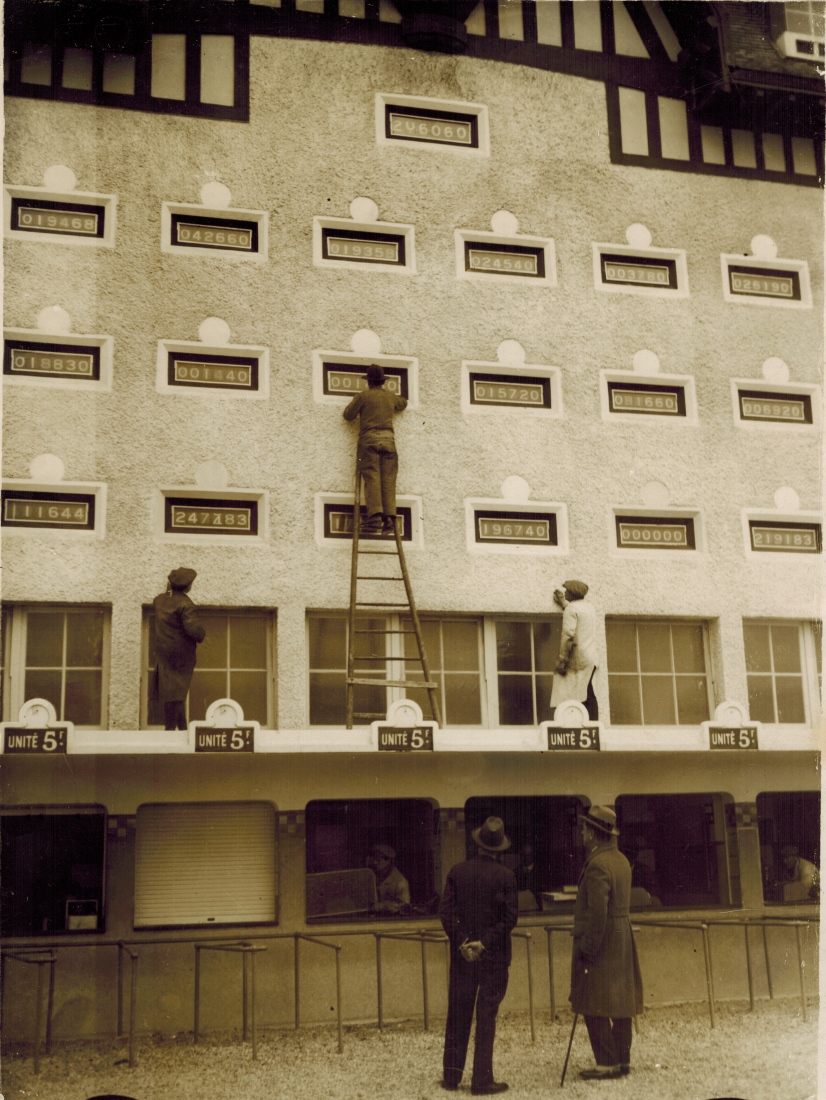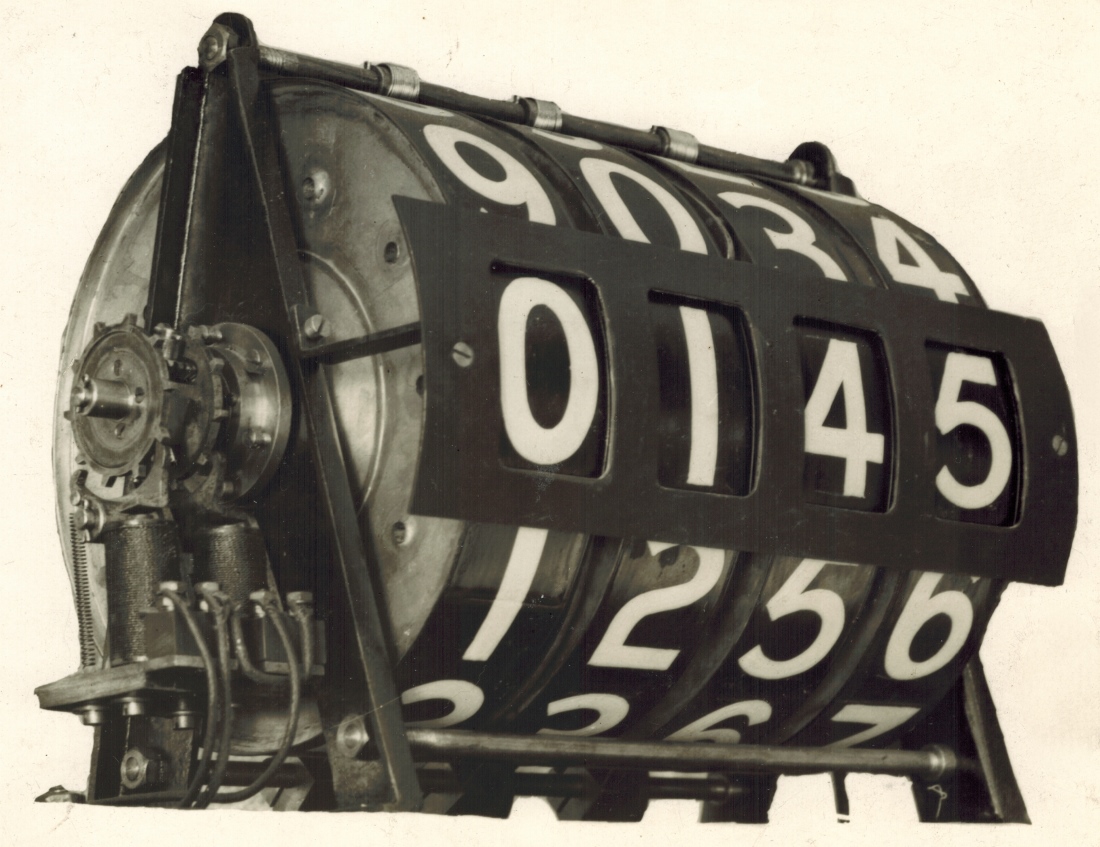A close up view of the Longchamps Pavilion
Click here or on the image to go back to the Photo Gallery

This history page contains a photograph which is one of several belonging to the photo gallery pages which are part of several pages relating to the invention of the world's first automatic totalizator in 1913 and Automatic Totalisators Limited, the company founded to develop, manufacture and export these systems.
The photographer's stamp on this photograph reads KEYSTONE VIEW Co. 100 Rue Richelieu (le Journal) Paris.
An Automatic Totalisators Limited company document titled The PREMIER (JULIUS) AUTOMATIC TOTALISATOR has a low resolution copy of this first image in it. It is titled FIG. 8. Portion of the front of the Main Totalisator Building, Longchamps. Paris. This image and the one in the company document come from the exact same photograph.
Following is a text extract from the company document mentioned, that appears in the vicinity of the photograph shown in this image. It introduces the elements of the system, firstly the Ticket Issuing Machines, which are being installed in the selling booths some of which can be seen in this image on the ground floor level in front of the two men standing together. Second, the Adding Machinery which is inside the machine room inside this pavilion and finally the Indicators. Part of one such indicator is seen on the upper face of the building in the image, a counter window of which the man on the ladder is working on. This indicator, consisting of all the counters in the face of the pavilion building, is an example of the type used on larger courses as mentioned in the following extract, where the Indicator is separate from the Adders. This extract is the fifth in a sequence of extracts from the company document, that are contained in multiple Photo Gallery pages in this website and immediately follows on from where the previous extract ended. The previous extract can be read in the Photo Gallery page accessible by clicking on this Pavilion image and scrolling down in the index table to the title Ceylon Turf Club Colombo and selecting the image thumbnail having associated text starting with the words The Julius Tote Runner and Pool Totals Indicator in the side of the grandstand at the Ceylon Turf Club...
The PREMIER (JULIUS) AUTOMATIC TOTALISATOR company document extract follows:
Description of the "Premier" Equipment.
The three main elements of the PREMIER AUTOMATIC TOTALISATOR are:--
- The ticket printing and issuing machines.
- The adding machines; and
- The indicators.
The TICKET ISSUERS are machines placed in buildings situated at various points on the racecourse, to suit the convenience of the public. Simultaneously with the issue of a ticket by the issuer, the transaction is electrically recorded on the ADDING MACHINES which are placed in some central building. These machines "total" all the tickets issued from the ticket selling machines and not only record the total number of bets on each horse, but also the aggregate number of bes on all horses in the race.
To display to the public the figures representing the progress of the betting, INDICATORS are used, and these, in the case of small installations, form a portion of the adding machines, which are so located as to show on large numbered drums "numbers" which record the totals of the investments made on each horse. On larger courses, where it is impossible, without great inconvenience, to bring all the bettors to one point on the course, Indicators are employed which are separate from the Adding Machines, but which automatically record, at all instants, the totals recorded by the adding mechanism. Usually, such Indicators are located wherever it is found necessary to establish a large group of selling booths, so that the public using this particular group of booths may be aware of the total of the investments made all over the Racecourse. Where additional mechanism is installed to make the further calculations required to determine the "Odds" on or against a horse, such mechanism forms a part of the Adding Machine, and the results of the calculations may be displayed on the front of the building in which such machinery is housed, or if required, auxiliary automatic indicators may be located anywhere else on the Course, to suit the convenience of the bettors.
The next extract from this company document, which immediately follows on from this extract and is titled Ticket Issuers, can be read by clicking on the pavilion image and scrolling up in the index table and selecting the image thumbnail with associated text starting The type of Julius Tote Ticket Issuing Machine used at Randwick Racecourse in Sydney.
This close up image of the Longchamps Pavilion, shows the Longchamps Julius Tote Runner and pool grand total counters. The pool grand total counter can be seen in isolation near the top of the building above all the other runner total counters. The Julius Tote machine room is probably inside this building. The machine room is shown in the first image in the Longchamps section of the Photo Gallery. In the second image after this one in the Photo Gallery you can see a partially assembled adder of the type used inside this building. A complete adder at Longchamps can be seen in the third image of the Longchamps section of the photo gallery. At ground level, six of the selling booths are visible, which housed six of the 273 J5 Ticket Issuing Machines. The lids of three of the J5s can already be seen protruding above the left hand side of the shelves of the three right hand selling booths. Interestingly, the fourth and fifth selling booths from the left hand side have a staff member in each, dressed in white collar tie and jacket giving them the appearance of sellers. If sellers they be, they are probably having a preview of the machines that they will soon be using. In the third and sixth windows are staff dressed in white dust coats and cap working on the installation. A close up view of one of these selling booths can be seen in the image following this one in the photo gallery.
The Julius Tote Machine Room also housed the scanners, which are Time Division Multiplexers and are part of the front end system. Two of the scanner frames can be seen in the fourth photo in the Longchamps section of the Photo Gallery. To view the other images in the Photo Gallery referred to above, click on the large image and then select the thumbnails of the suggested images.
With the work being done on the building it appears that the finishing touches are being applied to the installation which commenced in 1927. The white circles above each counter display are interesting. These could be lamps, which illuminate to indicate which runners are participating in the race, however from the second image in the Longchamps section of the photo gallery showing this system in use, it looks like the final product just has runner numbers permanently painted on these white circles to identify the associated runner total counters. Note that the pool grand total counter at the top of the image has no associated white dot, as it has no associated runners and only displays the sum of all the counters below it.
The company document extract above informed us that on larger courses, where it is impossible, without great inconvenience, to bring all the bettors to one point on the course, Indicators are employed which are separate from the Adding Machines. Following is an image of one of the type of counter wheel display elements that allows the Indicators to be remote from the Adders. As the Longchamps system was the first to implement remote indicators, I have included this image here. These runner displays received pulses from their respective Adders to show the associated runner's investment. This type of display unit is behind each of the counter windows in the image above, one of which the man on top of the ladder is working on. It is evident that the Longchamps system catered to a larger crowd with its associated larger investment and turnover, than the example of a display unit below as there are two extra digits in the Longchamps displays, four digits in the example display unit image below and six digits in the display units in the Longchamps image above. Having mentioned this, when the Longchamps Julius Totalisator commenced operation in 1928, it was the largest totalisator system in the world.
A counter wheel display only unit